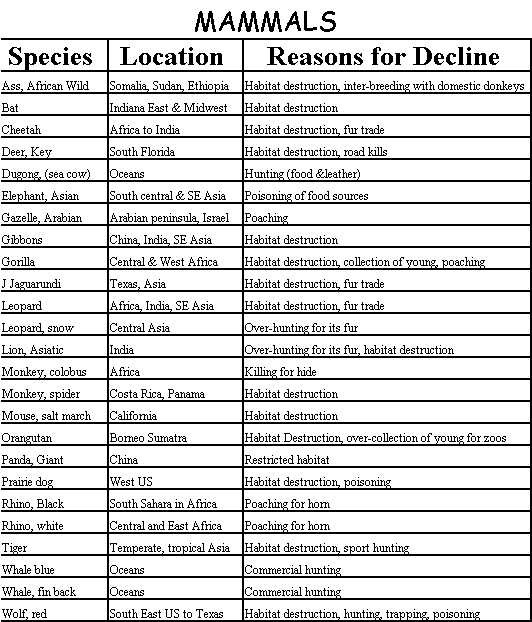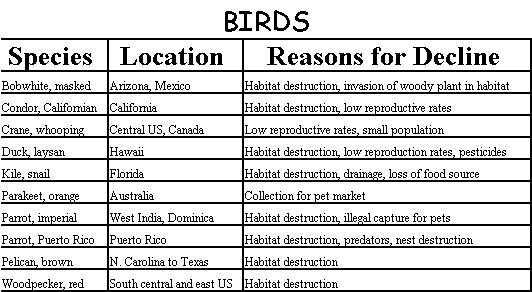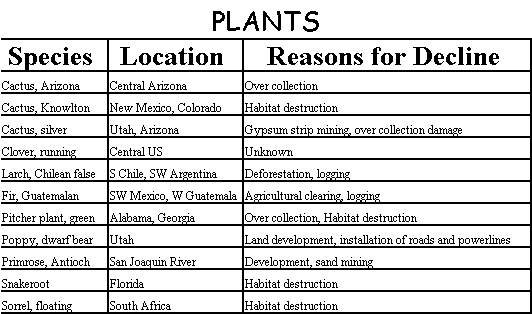Stephen Kingwell
ENDANGERED
SPECIES
What are endangered species?
Animals like rabbits and insects like flies are extremely common. They are not in danger of
dying out or becoming extinct. Yet other animals and plants species are very rare. Their
numbers have been greatly affected by environmental conditions that don't support that particular
species' survival in their current habitat. These species are listed by environmental researchers
as vary rare. They are placed on a register of "endangered species" in danger of dying out for
ever (see an excerpt of this register below).
When did `species' begin to disappear?
Ever since life began there have been endangered species. Throughout geological time, many
more species have become extinct than exist today. These species slowly disappeared because
of climatic changes and the inability to adapt to such conditions as competition and predation. It
is a natural part of evolution. Although the extinction of plants and animals is a natural part of
evolution, the number of species dying out per year has risen dramatically since the 1600s. If it
continues to increase at the rate at which it is growing now, 50,000 species will become extinct
each year by the turn of the century (see table below).

Dinosaurs once ruled the earth, but extinction ended thier future.
Why are there endangered species ?
Habitat DestructionSpecies become extinct or endangered for a number of reasons, but the
primary cause is the destruction of habitat. Man has seriously reduced available habitats
byDrainage of wetlands conversion of shrub lands to grazing lands cutting and clearing of forests
(especially in the Tropics, where the rain forests will be gone by AD 2000 if destruction
continues at its present rate) urbanisation and suburbanisation highway and dam construction.As
the various habitats become fragmented into "islands," the remaining animal populations crowd
into smaller areas, causing further habitat destruction. Species in these small islands lose contact
with other populations of their own kind, thereby reducing their genetic variation and making
them less adaptable to environmental change. These small populations are highly vulnerable to
extinction; for some species, the fragmented habitats become too small to support a viable
population.
Hunting for "Food and Fur"
Since the 1600s, commercial exploitation of animals for food and other products has caused
many species to become extinct or endangered. For examplethe slaughter of great whales for oil
and meatthe African rhinoceros, killed for its horn, the great auk became extinct in the 19th
century because of over-hunting the Carolina parakeet perished as a species because of a
combination of over-hunting and habitat destruction. Introduced diseases, parasites, and
predators against which native flora and fauna have no defenses have also exterminated or
greatly reduced some species. The accidental introduction of a blight, for example, eliminated
the chestnut tree from North American hardwood forests. Predator and pest control also have
adverse effects. Excessive control of prairie dogs, for example, has nearly eliminated one of
their natural predators, the black-footed ferret. In Australia the introduction of rabbits and cats
has caused the destruction of much of the wildlife. In Queensland the Great Barrier Reef is
under serious threat by the Crown of Thorns starfish.

The cutest of creatures, killed for its fur ...
Pollution
Pollution is another important cause of extinctions. Toxic chemicals _especially chlorinated
hydrocarbons such as dichloro-diphenyl-trichloroethane (DDT) and polychlorinated biphenyls
(PCBs)_have become concentrated in food webs, affecting most strongly those species at the
end of the chain. Both DDT and the PCBs, for example, interfere with the calcium metabolism
of birds, causing soft-shelled eggs and malformed young. PCBs also impair reproduction in
some carnivorous animals. Water pollution and increased water temperatures have wiped out
endemic races of fish in several habitats. In Western Australia blue-green algae clogs the Swan
and Canning Rivers. This algae thrives because of the amount of garden fertilisers that get
washed into the waterways. The algae blocks oxygen supplies reaching the fish in the rivers and
their numbers are at great risk.
Unbalanced Food Web
The Food Web set of interconnected food chains by which energy and materials circulate within
an ecosystem. These webs are made up of individual food chains. In a grazing web, materials
typically pass from plants to plant eaters (herbivores) to flesh eaters (carnivores). In a detrital
web, materials pass from plant and animal matter to bacteria and fungi (decomposers), then to
detrital feeders (detritivores), and then to their predators (carnivores).If one link in this food
chain happens to become extinct there would be an imbalance in the chain. The consequences
would be, that those animals that rely on that particular part of the food chain, if they are unable
to adapt to knew or different food sources, will die. For example, the Australian Koala can only
eat a particular species of gum leaves but habitat destruction has reduced the quality and quantity
of those gum trees. The Australian Koala is on the brink of becoming an endangered species.

It wouldn't be Australia without Koala's, but it might have to be
What's being done to help?
Some private and governmental efforts have been mobilised to save declining species. One
immediate approach is to protect a species by legislation. Countries all over the world make
laws to ensure that there are mechanisms for the conservation of ecosystems on which
endangered species depend. In 1972 the Environmental Protection Agency was established in
America. Australia has also established agencies through Acts of Parliament (The Endangered
Species Act 1992) and the Wildlife Protection Authorityto discouraged the exploitation of
endangered species within Australia. It also supports other countries efforts by banning the
importation and trade of any product made from such species. Countries have various
agreements with other nations_for example, USA with Canada and Mexico for the legal
protection of migratory birds.
International efforts center on the Convention on International
Trade in Endangered Species of Wild Fauna and Flora, ratified by 51 nations. Its purpose is to
restrict exploitation of wildlife and plants by regulating and restricting trade in species. The
effectiveness of such laws in various countries, however, depends on enforcement and support
by people and the courts. Because of a lack of law enforcement, the willingness of some
segments of society to trade in endangered species, and the activities of poachers and dealers
who supply the trade, the future of many species is in doubt in spite of legal protection.
Australian species of wildlife are in great demand because they are unique, especially bird-life.
Recently, in Australia, penalties for trafficking in protected and species have been increased.
The court system is committed to strict application of the laws.
What are scientists doing to help?
In an efforts to save endangered species scientists are propagating breeding stock for release in
the wild, either to restore a breeding population (as in the case of the peregrine falcon) or to
augment a natural population (as in the case of the whooping crane). Due to breeding in
captivity, the number of known California condors had risen from 27 in 1987 to 52 by 1992.
Researchers are also involved in the determination of critical habitats that must be preserved for
endangered species. These habitats may be protected by the establishment of reserves; the value
of these may be limited, however, because of the island effect.In Australia environmentalists have
lobbied for special locations such as Kakadu National Park to be included in the World
Heritage Register in an effort to protect the species that make up this area. Scientists also have
an important role in informing the public of the value of many species and the risks of loosing
biodeversity through lack of commitment to the environment. In Australia scientists have
introduced diseases that only attack pests like rabbits to remove a major enemy of many wildlife
species.
Who is Greenpeace

Greenpeace is a privately run and funded worldwide organisation whose sole aim is to bring
environmental problems to the attention of the world.Greenpeace has actively campaign against
whaling and the killing of animals for their luxury furs. This organisation tries to act as the
conscience of the world. It watches how governments and multinational corporations behave
towards the environment. For example it has targeted Japanese corporations who still are
involved in whaling and African countries who don't put maximum effort in applying the laws
against poaching of endangered species.
Endangered Species List (extract only)



REFERENCES






